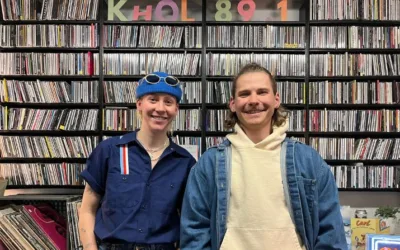Founded as a multicultural dance company in 1982, the Bill T. Jones/Arnie Zane Company is recognized as one of the most innovative and powerful forces in the modern dance world. The company’s current production–titled “What Problem?”–probes the tension that exists between belonging to a community and the feelings of isolation that many feel during these difficult times.
25 community members joined Bill T. Jones, 10 company members and four vocalists for two recent performances of a “dancing meditation” at the Center for the Arts on March 18 and 19. KHOL Music and Community Affairs Director Jack Catlin interviewed company members Barrington Hinds and Shane Larson ahead of opening night.
The following interview transcript has been edited for clarity and brevity.
JACK CATLIN/KHOL: The source material [for this production] comes from a diversity of eras and authors: [Rapper] Kendrick Lamar, Martin Luther King, W.E.B. Du Bois and Herman Melville. How does that come together in your performance?
SHANE LARSON: There are a lot of really colorful kinds of materials in this work and a lot of really bold materials. And something that Bill talks a lot about is abstraction: taking something and doing something to it, and how those things talk to each other in different ways that aren’t necessarily just reading the “I Have a Dream” speech forward or listening to a Kendrick Lamar song. If you take those lyrics and have someone sing them over something else while someone is moving on stage, right? How do the parts now talk to each other? So, a lot of it, I think, is coming from abstraction.
BARRINGTON HINDS: Yeah, I would say abstraction too and kind of metaphorically with Melville. He talks about one character, the black cabin boy, Pip, and how Bill never remembered as a child reading it–he never remembered Pip. But now as an adult, he remembers him, and he’s questioning, ‘Why didn’t I remember him?’ And in a way, Pip is isolated. If you’ve read the book [“Moby Dick”], he falls into the ocean and his mind cracks and he falls to the bottom of the ocean and he sees God. So, it’s kind of like Bill talking about that isolation, the grandness of the ocean [and] how do I fit in the avant-garde, our culture? How do I fit in society? And so there’s a lot of things that are used that are abstract, and the company itself, we use a lot of shapes. There are a lot of mediums being used.
LARSON: Yeah, and back when Bill and Arnie were experimenting at Binghamton, they were really interested in experimental filmmakers. You know, Stan Brakhage and a lot of people like that. And so they really love trying to take apart all the frames of something. And a lot of times those things became shapes, and I would say our practice around shapes right now is creating a kind of DNA for the piece and how the shapes transform throughout the piece: How they become manipulated, how we use them. Going back to what Barrington was saying about this character, Pip, I think what’s really interesting is that this character is only mentioned in one chapter of the book. I mean, “Moby Dick” is huge, and to quote Bill in the piece, ‘And his shipmates called him mad.’ He falls to the bottom of the ocean, and he comes back up and his mind is cracked. His shipmates think he’s crazy. And Bill sees himself in that. You know, he comes out as kind of this survivor and the captain takes him in and thinks that he’s wise. And so there are a lot of sociopolitical things going on with, ‘Who are we listening to? What kind of experiences do we make for other people or think that they’re going through?’ I mean, there’s so much to unpack.
HINDS: Yeah, I mean, just the title of itself, “What Problem?,” I think we live today in a society that’s like, so ‘choose a side’ and you might feel isolated and like, ‘I’m the problem.’ Instead of thinking like, ‘No, we’re all human beings,’ like, ‘Can we be a community? Can we come together and fix the issues of today?’
LARSON: Even talking about picking sides, something that I’ve been talking a lot about with Bill lately is, ‘What are you pushing against?’ Bill really believes that a lot of kinds of things that we’re making onstage are pushing against something, fighting for something, or maybe even moving through the discomfort. It doesn’t always come out of nothing. What we’re making is coming from the times that we’re living in, the things that we are dealing with, pushing against.
KHOL: So, that’s a good segue to my next question: What does the word ‘problem’ mean to both of you in the context of this production?
LARSON: Going back to that, the quote, this title comes from the problem of the color line. So, for me in this piece, when we’re talking about the company members as other Pips, I’m honestly thinking about myself as a white person making art in this piece in a predominantly Black company. I mean, identity politics is something that we’re all kind of dealing with right now. But I think kind of wisely, even, we started working on this piece four years ago and think about how much identity politics has come up now. So, I think that speaks to a lot of what we’re saying, you know, pushing against things. And also kind of Bill’s interesting, he always has this interesting kind of psychic way about him that these are things that we were really talking about four years ago and how prevalent they are now. Not that they weren’t prevalent then, but how much now it’s in the nation’s eye, at the forefront.
HINDS: Yeah, I mean, for me personally, I’m from a Jamaican family. I’ve definitely had to deal with things about race and have had to act a different way and be ten times better. So, yeah, instead of just feeling like what the majority says, the white male would feel–I don’t know how that feels. I take it upon myself of bringing that, my own experiences. Especially dance too, my parents never knew anything about dance, and I kind of just fell into it and they didn’t know what I was really pursuing. And they said, ‘You can’t make a job out of that. Like, how are you going to survive? You need to be a doctor. You need to be in finance, you need to make money.’ So, it’s pushing all those things. I found a career that usually is for people that have access. That in itself, to actually come this far, to be in the profession, I feel for one really blessed but it’s been a struggle. Do you know what I mean? Yes, I have an advantage of being a man in a career that’s mostly women but there are definitely things that I had to overcome to get here.
LARSON: I like that you bring that up. It’s a career of privilege for sure but it’s still not easy.
KHOL: And this is all going on during your performance…
LARSON: I would say all of it. Yeah. Yes, all of it is.
KHOL: Yeah, it’s like actively in your mind while you’re performing.
LARSON: And actually, what I like about pieces of this piece is these are actually conversations that we’ve had as a company together. We’ve done a lot of time discussing how we, as individual pieces in the machine, fit into this greater thing that we have been making.
Listen above for KHOL’s full conversation with Bill T. Jones company members Barrington Hinds and Shane Larson.
This coverage is funded in part with an Arts For All grant provided by the Town of Jackson and Teton County.





